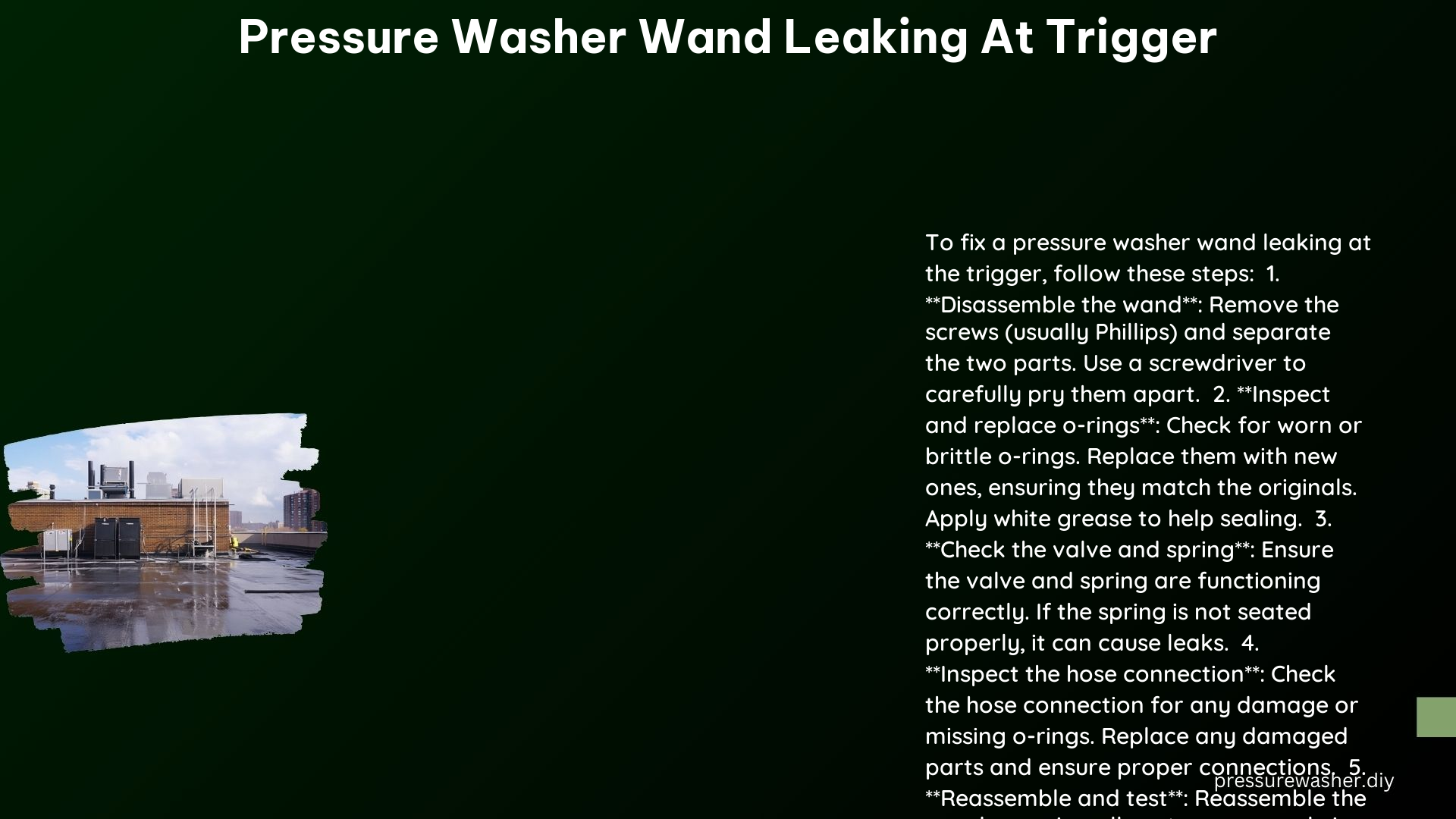Pressure washers are powerful cleaning tools that make quick work of tough grime and dirt, but when the wand starts leaking at the trigger, it can be a frustrating and potentially dangerous issue. In this comprehensive guide, we’ll dive deep into the common causes of pressure washer wand leaks at the trigger and provide step-by-step instructions on how to fix them, ensuring your pressure washer operates at peak performance.
Causes of Leaking at Trigger
1. Damaged or Worn Out O-Rings
The o-rings in your pressure washer wand are responsible for creating a tight seal and preventing leaks. Over time, these o-rings can become brittle, cracked, or worn out due to the high-pressure water flow and exposure to various chemicals. Inspect the o-rings closely, and if they show signs of wear or damage, it’s essential to replace them immediately.
When replacing o-rings, be sure to use ones specifically designed for high-pressure applications. The typical o-ring size for a pressure washer wand is 9/16″ x 3/32″, but the exact size may vary depending on your model. Apply a small amount of white lithium grease to the new o-rings before reinstalling them to ensure a proper seal and smooth operation.
2. Loose or Faulty Connections
Another common cause of leaks at the trigger is loose or faulty connections. Ensure that all the connections, including the wand to the high-pressure hose and the trigger assembly to the wand, are tight and secure. Use a wrench to tighten any loose connections, and inspect for any cracks or damage that may require replacement of the affected parts.
3. Faulty Trigger Mechanism
The trigger mechanism itself can also be the source of leaks. Over time, the internal components, such as the spring, valve, and intake hose, can wear out or become damaged, leading to leaks. If tightening the connections and replacing the o-rings doesn’t solve the issue, the entire trigger assembly may need to be replaced.
Fixing a Leaking Pressure Washer Wand at the Trigger

1. Release Stored Pressure
Before attempting any repairs, it’s crucial to release any stored pressure in the system. Turn off the pressure washer engine and pull the trigger to release the remaining pressure. This will ensure your safety and make the disassembly process easier.
2. Inspect and Replace O-Rings
Disassemble the wand by unscrewing the trigger assembly or any other removable parts. Carefully inspect the o-rings and replace them if they show signs of wear or damage. When reinstalling the o-rings, apply a small amount of white lithium grease to help them seat properly and create a tight seal.
3. Check and Tighten Connections
Examine all the connections, including the wand to the high-pressure hose and the trigger assembly to the wand. Use a wrench to tighten any loose connections, and replace any damaged parts, such as cracked fittings or worn-out washers.
4. Replace the Trigger Assembly (if necessary)
If the trigger mechanism is the source of the leak, you may need to replace the entire trigger assembly. Carefully disassemble the trigger assembly, taking note of the orientation and placement of the internal components, such as the spring, valve, and intake hose. Replace the entire assembly with a new one, ensuring proper alignment and secure connections during reassembly.
Additional Tips
-
Never Repair High-Pressure Hoses: High-pressure hoses should never be repaired, as they are designed to withstand extreme pressures. If the high-pressure hose is leaking, it must be replaced to avoid the risk of personal injury or death.
-
Use the Correct Tools: Ensure you have the appropriate tools, such as Phillips screwdrivers and wrenches, to disassemble the wand without causing any damage.
-
Keep Track of Small Parts: During the disassembly process, store small parts like screws and washers in a container to prevent them from getting lost.
Technical Specifications
O-Ring Replacement
When replacing the o-rings, be sure to use ones specifically designed for high-pressure applications. The typical o-ring size for a pressure washer wand is 9/16″ x 3/32″, but the exact size may vary depending on your model. Apply a small amount of white lithium grease to the new o-rings before reinstalling them to ensure a proper seal and smooth operation.
Trigger Assembly
The trigger assembly typically includes a spring, valve, and intake hose. Ensure that all these components are properly aligned and secured during the reassembly process. If any of these parts are worn or damaged, it’s best to replace the entire trigger assembly to ensure proper functionality and prevent future leaks.
Reference Links
- Simpson Cleaning – Troubleshooting Spray Gun Leaking: https://simpsoncleaning.com/troubleshooting-spray-gun-leaking/
- YouTube – How to Repair a Pressure Washer Wand: https://www.youtube.com/watch?v=TUiCTmIDEtI
- YouTube – How to Fix Leaking Pressure Washer Wand (CHEAP): https://www.youtube.com/watch?v=GXnhHy_NEPE
